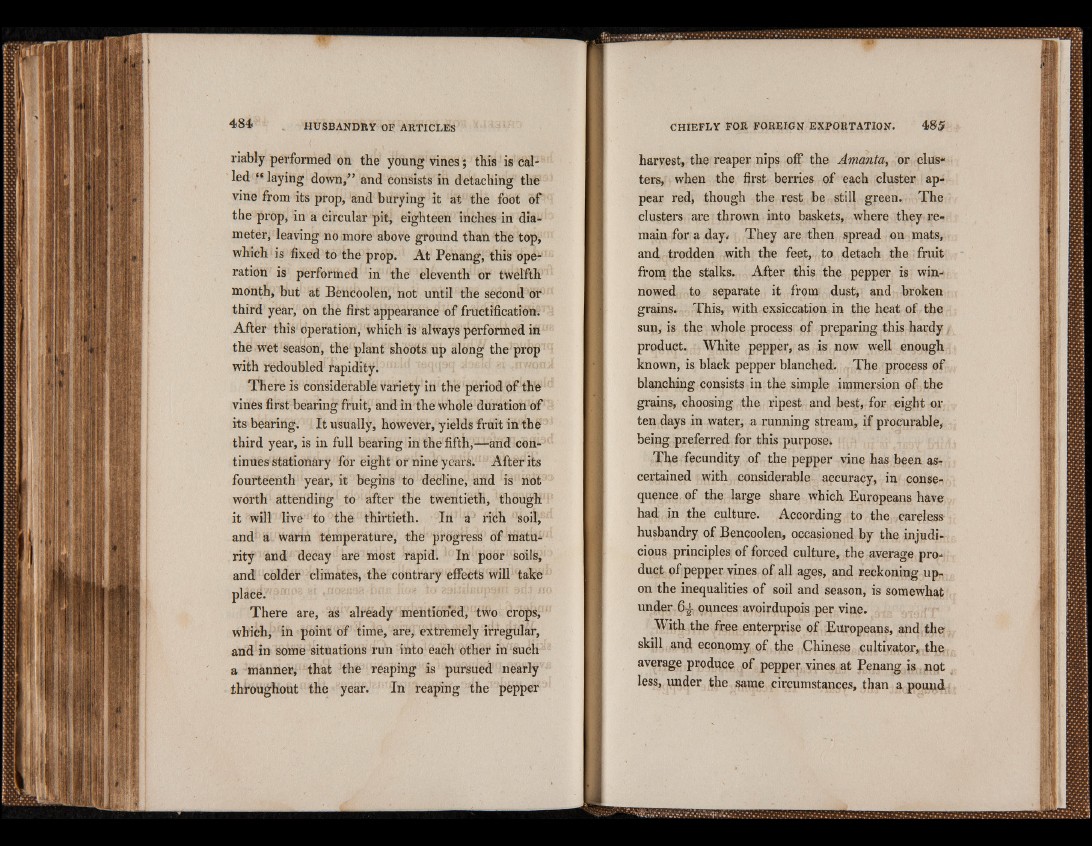
riably performed on the young vines; this is called
“ laying down/’ and consists in detaching the
vine from its prop, and burying it at the foot of
the prop, in a circular pit, eighteen inches in diameter,
leaving no more above ground than the top,
which is fixed to the prop. At Penang, this operation
is performed in the eleventh or twelfth
month, but at Bencoolen, not until the second or
third year, on the first appearance of fructification.
After this operation, which is always performed in
the wet season, the plant shoots up along the prop
with redoubled rapidity.
There is considerable variety in the period of the
vines first bearing fruit, and in the whole duration of
its bearing. It usually, however, yields fruit in the
third year, is in full bearing in the fifth,—and continues
stationary for eight or nine years. After its
fourteenth year, it begins to decline, and is not
worth attending to after the twentieth, though
it will live to the thirtieth. In a rich soil,
and a warm temperature, the progress of maturity
and decay are most rapid. In poor soils,
and colder climates, the contrary effects will take
place.
There are, as already mentioned, two crops,
which, in point of time, are, extremely irregular,
arid in some situations run into each other in such
a manner, that the reaping is pursued nearly
throughout the year. In reaping the pepper
harvest, the reaper nips off the Amanta, or clusters,
when the first berries of each cluster appear
red, though the rest be still green. The
clusters are thrown into baskets, where they remain
for a day# They are then spread on mats,
and trodden with the feet, to detach the fruit
from the stalks. After this the pepper is winnowed
to separate it from dust, and broken
grains. This, with exsiccation in the heat of the
sun, is the whole process of preparing this hardy
product. White pepper, as is now well enough
known, is black pepper blanched. The process of
blanching consists in the simple immersion of the
grains, choosing the ripest and best, for eight or
ten days in water, a running stream, if procurable*
being preferred for this purpose#
The fecundity of the pepper vine has been ascertained
with considerable accuracy, in consequence
of the large share which Europeans have
had in the culture. According to the careless
husbandry of Bencoolen, occasioned by the injudicious
principles of forced culture, the average product
of pepper vines of all ages, and reckoning upon
the inequalities of soil and season, is somewhat
under 6-L ounces avoirdupois per vine.
With the free enterprise of Europeans, and, the
skill and economy of the Chinese cultivator, the
average produce of pepper vines at Penang is , npt
less, under the same circumstances, than a pound